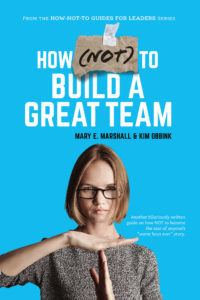Mary E. Marshall's Blog, page 10
May 18, 2021
Hiring: Day One Dilemma
 First Day at Large Technology Company in Redmond, Washington
First Day at Large Technology Company in Redmond, Washington
Nancy had just started her new position as a mid-level executive in the marketing division at Large Technology Company after going through a two-month recruiting and interviewing process. She interviewed with over ten different people and went through multiple rounds of testing. It was the most difficult process she had ever experienced in her career, but it resulted in an offer for her dream job at her dream company. She felt it was worth the canine obstacle course she’d had to go through to get the job. It’s everything she wanted; she was thrilled!
The night before she was to start, she received an email from her new boss informing her that he would be out of town for two weeks and that the team would be taking care of her. This added a certain level of stress to her first day, but after the interviewing process she felt as if she had earned her place on the team, and it didn’t overly concern her. However, it did add an element of doubt to her ability to be successful.
Upon arrival, there was no one to greet her, several empty cubicles in the section she was supposed to be in, and no direction, orientation, or any other indication as to what she should be doing. As a resourceful person, she started asking around among her fellow teammates. The most popular answers were “I don’t know,” “not sure,” “call HR,” “wait till John gets back,” and even a “who are you?” None of these filled her with confidence that she had made the right decision to come to work at this company.
She attempted to get a hold of HR but was shuffled around multiple times. She was vaguely sure she had the right cube identified. When the manager had previously met with her for the offer, he had gestured in the general direction of that cube. Day one was spent setting up the cube with things she would need—or what she thought she would need. Day two was much the same, and by day three HR had been in touch and helped set up her email account, but she still had no computer. Remember, this was one of the tech behemoths. She was getting anxious.
By day five she had managed to get in touch with IT and got a computer, but now didn’t know what she was supposed to do with it. She decided to interview her teammates to find out what they were working on and what they thought she should be working on. The following week she did more of the same and started familiarizing herself with the various software platforms and brand guidelines for the partners—with very little help or input from her team. They were treating her like an interloper and made her feel like she didn’t belong. She was wishing she had taken the other offer.
Finally, after two weeks, John returned from vacation and asked what she had been up to. In a non-judgmental way, she tried to explain that she was a little surprised by the lack of direction, orientation, and collaboration from the team. John just smiled and said, “Welcome to the team. Sounds like it went as it should have!”
What she now knew was that if she were to succeed, it would always be on her own. Full stop.
MEMO TO FILE FROM JOHN:New employee started two weeks ago; sounds like everything went great. It was unfortunate that I had to take that trip to Bermuda at the last minute, but how could I say no to my buddies? She was resourceful and figured things out—exactly as I planned it, even if I hadn’t had to take that personal trip! She got the purposeful cold shoulder from the team because she might be taking one of their jobs one day. And they pretty much hazed her like they all were hazed on their first weeks on the job. Survival of the fittest and all that. If more companies would take this approach, we wouldn’t have such needy and dependent employees.
They need to learn how to be independent and stand up for themselves. No free lunches here. None of the BS about touchy-feely onboarding—that is strictly for wimps. Not the warrior workplace I love and thrive in. If one of your own gets eaten now and then, so be it; only the strong survive. A little natural selection is a good thing when building a solid team. (Note to self: Keep this for upcoming book on CrossFit Leadership.)
LET’S GET REALThis is NOT how you onboard someone. They’ve just spent weeks or months going through interviews, stressing, preparing, and then making a choice to come work for you. They are probably leaving another job and possibly choosing between multiple offers. They start off so hopeful. Why would you want to ruin that on day one by purposely not reinforcing that they’ve just made a great decision to come work for you?
Make day one count. Don’t have them fill out forms for the day or, as our example above, ignore them. Celebrate that they made the right decision; show them you’re excited that they are here. Have all their equipment and paperwork ready on their first day so they can be productive. Take them out to lunch or have a team lunch to reinforce their welcome by the company. Based on your company’s values, have others share why this company is a good place to work. Take them around and introduce them to their team members or as many people as possible.
The last thing you want is them going home and telling their partner or family that it was the worst first day and they think they may have made a mistake. Or worse, they don’t want to go back for day two.
When someone leaves—assuming it’s a retirement or a promotion to another position or company—we usually give them a heartfelt goodbye-and-good-luck party. We celebrate who they are and their contribution to the company. Why shouldn’t we start out this way as well?
Think about your kid’s first day of school: if the teacher spends most of his or her time demonstrating to the kids that it’s going to be fun, they are going to be accepted, they are going to like it, and will want to return. The first day of a new job should be no different.
To purchase a copy of How (NOT) to Build a Great Team click here.
The post Hiring: Day One Dilemma appeared first on Mary Marshall // CEO Coach.
May 12, 2021
We Love You, You’re Hired
 Sent: July 25, 11:30 p.m.
Sent: July 25, 11:30 p.m.
From: CEO
To: Executive Team
Subject: Jim’s Interview
Hi, everyone. Thanks for taking the time to interview Jim McDonald this afternoon. He comes highly recommended by our board for the VP of Sales position. I know he’s the first and only candidate we’ve interviewed, but let’s fast-track the feedback loop. We need to get our numbers back up by the end of Q3. Reply all and let me know what you thought of him!
Reply All From: Suzanne, Dir. of Operations
To: Executive Team
Subject: Jim’s Interview
I thought he was great! Very high on the likability index!
Reply All From: Bob, Dir. of Product Strategy
To: Executive Team
Subject: Jim’s Interview
Small world. Turns out he used to work at the same company as my brother. They were in different departments though. Seems like a nice guy.
Reply All From: Carol, Dir. of Customer Experience
To: Executive Team
Subject: Jim’s Interview
He’s funny! I bet our customers would love him.
Reply All From: Jane, Dir. of Technology
To: Executive Team
Subject: Jim’s Interview
He’s fine. I won’t really interact with him, so I don’t care. Just please make sure he’s not a technical troglodyte. I don’t have time to babysit the sales guy’s laptop problems.
Reply All From: Diane, Dir. of Marketing
To: Executive Team
Subject: Jim’s Interview
He’d make a great travel partner for my upcoming trade shows—seems like a lot of fun. Great culture fit!
Reply All From: Joe, Associate VP of Sales
To: Executive Team
Subject: Jim’s Interview
I don’t really know what I’m supposed to be working on right now, so yeah, it would be great if I could have a manager sooner rather than later. When can he start?
When you’ve got an open position as important as a revenue-generating position like VP of Sales, get a butt in that seat ASAP! There’s no time to waste. Every minute that position isn’t filled, there is money falling through the hole in the bottom of the boat and the boat is taking on water quickly.
Don’t waste time or money with recruiters or headhunters. When someone as important as your Founder or your Board refers a candidate, consider it a slam dunk! Get that person in for an interview loop right away with your senior-most people and fast-track the feedback loop. Being accepted and liked by your senior team is the most important qualification—you can fill in the skill gaps later. Like they say, hire for culture first, skills second. If he’s well-liked, your team will be more apt to do his job for him so he’s successful and won’t cause unnecessary performance pressure on the rest of the team.
The fact that your Founder or your Board doesn’t really understand the requirements of the position is beside the point. They know what’s best and will be flattered if you hire one of their referrals without question. If things go poorly down the road, you can blame them.
LET’S GET REALReply All From: Sue, Director of Human Resources
To: Executive Team
Subject: Jim’s Interview
DID ANYONE ASK HIM IF HE CAN SELL? Just curious.
“Hire slow, fire fast” is one of the most important mantras of good team building. A deliberate, thoughtful, and strategic hiring process is the best investment you can make in your company. Yes, while hiring to values and culture is incredibly important, don’t forget that you are hiring people for their skills and their ability to get the job done and add value to the business.
All too often, interview loops and hiring procedures are so rushed and informal that candidates aren’t vetted for skills at all. They are assessed for their likability and “fit,” and because they were referred from a credible source or “look good on paper,” the assumption is made that they can do the job. Here are a few tips and tricks to make sure you get the proof before you make the hire:
Invest in professional recruiting. It is always worth the money to hire a reputable professional recruiter or headhunter for senior hires. Negotiate a smart deal, and make sure they are financially motivated to guarantee that your new hire is successful. They’ll ensure that you vet multiple candidates, help you avoid the temptation to move too fast, and run a fairTalk to Really talk to referrals. Never think of checking referrals as “checking a box” in the recruiting process. Try to have thoughtful conversations, ask unexpected questions, and consider looking for hints and clues in their answers.Do background research via networking. Find out where this person stands in your industry, what their reputation is—and, yes, dig into their LinkedIn profiles and Google them. Take the time to find out as much as you can about both their character and their skills. Make professional background checks a standard policy for every new hire, it’s easy to outsource, affordable, and worth it.Require specific proof-points. Don’t be shy about asking for work samples (writing samples, presentations, videos, proposals, etc.) that back up the candidate’sIt is far better to have a vacancy than a bad fit. Some say the cost of a bad hire is the equivalent of three times that person’s annual salary. From disruption to the organization, to bad PR, to a “do-over” in the hiring process, a rushed or bad hire can be incredibly costly. Take the time to do it right; insist that your interviewers take the process seriously, ask smart questions, and deliver thoughtful feedback to you.
If the open position is a management position, you may decide to include their potential subordinates in the vetting process. Should you do so, make sure they understand that they are not part of the decision-making process, but that their opinions are valuable by giving them something specific to probe for or score against. Having subordinates focus on a values fit is an excellent way to include them in the process.
Never hesitate to bring candidates in for a second round, and certainly don’t feel like you’ve wasted their time by doing so. A smart, great-fit hire is as valuable to them as it is to you. So, beware the impatient candidate; they should share your desire to take all the time that’s needed to make sure it’s a win-win for everyone. Even if you’ve narrowed the field to a single candidate, multiple rounds of interviews are expected and accepted by most jobseekers.
To purchase a copy of How (NOT) to Build a Great Team click here.
The post We Love You, You’re Hired appeared first on Mary Marshall // CEO Coach.
May 4, 2021
Too Close to Home: Hiring Is Relative
 Sent: August 25, 3:00 p.m.
Sent: August 25, 3:00 p.m.
From: Karen, Founder
To: John, CEO
Subject: My Brother-in-Law
John,
I realize we don’t have any open positions in the warehouse right now and that I’ve been asked pretty specifically not to get involved in hiring or staff decisions, but I’ve got a huge favor to ask. My brother-in-law, Kenny, is a terrific guy and is looking for a job. He’s been down on his luck for the past ten or fifteen years as he got mixed up in some shady business a while back at his previous job. He and my sister are divorced now, but I always liked Kenny, and I feel like we could really help with his re-entry into society if we offer him a job. I’ll take full responsibility for it, and the team doesn’t need to know anything about his personal life or the assault/burglary conviction. He deserves a second chance. Let’s do it.
He can start on Monday and report to Mike. I’m sure Mike will understand, and you’ll do a great job of explaining it to him.
~Karen
Oh, most definitely, this is a terrific idea! You own the company and can do whatever you want. So, go for it. Jobs are hard to come by, and you’ve got plenty of them to go around, so be sure to put your friends and family at the top of the list—especially the ones that would have a hard time finding a job anywhere else. Providing jobs for your inner circle will make you feel good about yourself, secure your position as family matriarch or patriarch, and allow you to assert control over your friends and family. An important part of being a good leader is totally blurring the lines between business and personal. For you, it’s ALL business, all of the time! If you can use your friends and family to help boost your bottom line, by all means, do so.
Just like there is always a job for the hanger-on-er, there is always a job that can be created for any member of your family. The rest of your staff will be impressed by your loyalty to your family and your gigantic generous heart, particularly if your family member has no skills, relevant experience, or subject-matter expertise to contribute. If you experience any backlash from your employees, be sure to use your company values as an excuse for your decisions. For instance, if “learning” is one of your company values, you can simply explain that you’ve hired an individual with no experience to help employees learn more about things that have nothing to do with your business. “Expanding our horizons,” as they say.
If you’re hiring family members that may seem riskier than others, like Kenny, explain it away by saying you’ll take responsibility for anything that goes wrong but do everything in your power to keep any family skeletons squarely in the closet! One of the many benefits of hiring friends and family that would have a hard time finding work elsewhere is that you can pay them well below the pay grade for that position. Quid pro quo.
Your hiring managers can’t say no; it’s your company and you can do what you want. After all, hiring unqualified family and friends makes you a huge hero in your eyes. And that’s a win-win for you!
LET’S GET REALThis is a tricky one, so let’s unpack it.
While there are many family-run businesses that have been well run and successful for generations, there are probably just as many that have failed as a business or caused huge fissures in the family. Those examples aside, there are private and public businesses that are not family-run and have no preconceived requirements to hire or employ members of a biological family. It’s our belief that in these businesses, hiring family and friends should be avoided at all costs. Like plague-level avoidance. It simply never works out in the long run.
More often than not, the fact that a family member or friend is available for a position seems to take precedence over their qualifications. Unless you had already instituted a work-release program in your organization, you wouldn’t hire Kenny if he was a complete stranger, so why hire Kenny since he’s family? It may be good for Kenny, but it’s not good for your company. Your duty is to the company. Regarding Kenny’s situation specifically: Please remember there are organizations and services qualified and trained to assist employees with special circumstances and needs. The ability to write a paycheck does not qualify you as an employment specialist for people with these or other types of extenuating circumstances.
On the other hand, if the family member or friend is entirely qualified for a position in your company, ask yourself these very important questions: Are they more qualified than any other candidate? Are you sure that their relation to you isn’t part of that qualification? Is it entirely based on skills and relative experience? If you still want to tell yourself that you are being objective about this decision, then continue on, but tread lightly.
Regardless of your self-perceived objectivity, your staff will most likely not feel the same. And no matter how skilled your family member or friend is, they will have to work overtime to prove themselves to a staff that suspects favoritism and nepotism. This scenario isn’t fair to anyone involved, isn’t worth the feel-good that you will temporarily receive, and in all likelihood will end up being an embarrassing blip on the employee’s résumé.
To purchase a copy of How (NOT) to Build a Great Team click here.
The post Too Close to Home: Hiring Is Relative appeared first on Mary Marshall // CEO Coach.
April 27, 2021
Hiring: It’s OK Just This Once
 Notes for an upcoming book on leadership from the desk of the tone-deaf leader: When hiring, way too much value is placed on values. (Ohh, that’s a great title! Man, I’m so clever!) This seems to be the new buzzword, but frankly, it’s completely overrated. My experience has been that people tell you things about their values but don’t really mean them. I mean, let’s get real, who among us hasn’t eaten the fruit and veggies at the grocery store, or not returned money when they undercharge you? It’s the grocery store, after all, and they make plenty of money. And I hate that ridiculous saying that your real values show up when no one is looking—if no one is looking, it absolutely doesn’t count. I counter that if a tree falls in the woods and no one hears it, did it really happen? My point made.
Notes for an upcoming book on leadership from the desk of the tone-deaf leader: When hiring, way too much value is placed on values. (Ohh, that’s a great title! Man, I’m so clever!) This seems to be the new buzzword, but frankly, it’s completely overrated. My experience has been that people tell you things about their values but don’t really mean them. I mean, let’s get real, who among us hasn’t eaten the fruit and veggies at the grocery store, or not returned money when they undercharge you? It’s the grocery store, after all, and they make plenty of money. And I hate that ridiculous saying that your real values show up when no one is looking—if no one is looking, it absolutely doesn’t count. I counter that if a tree falls in the woods and no one hears it, did it really happen? My point made.
However, because it’s the latest craze in hiring and “culture,” we have to at least pretend we’re paying attention to it. So figure out your value words, plaster them all over the place, and then hire based on some of these values but certainly don’t make it the top priority. It’s one of the surface things that you need to “show,” but doing anything about it is a completely different animal. Just slow your roll on that one.
To prove my point, we just hired this great guy for sales. He was the top producer at his last company, one of our competitors, and we scooped him up as soon as he was available. Not really sure why he had to leave that company, and quite frankly, don’t care because he’s so good. After I hired him, he told me he knew the other candidate that we had been considering, and he’d made an anonymous call to the guy’s wife to tell her bad things about our company. After my initial shock, he explained that he’d wanted the other candidate to drop out so he could get the job—I loved it! No wonder he was a winner. I love the creativity.
And creativity is one of our values, so score one for me on hiring this guy. Now, we also have a value of collaboration, which means he needs to work well with others, and that’s not going as well as I had hoped. However, he’s bringing in the numbers, so I don’t care much about everyone liking him. It’s not as important as getting those sales. Numbers trump everything in this business. I just need to work with him a little and teach him how to collaborate in a way that looks like he’s being a team player. Then no one will care what he’s doing behind the scenes to make the deals happen. Trying to collaborate is as good as I need to see.
UPDATE TO NOTES:Unfortunately, I had to let my star sales guy go today. It was such a hard thing to do, but when the police showed up and shared with us that he had been selling some of our systems outside of the company, I really didn’t have a choice. I had initiated the investigation but certainly didn’t expect it to come back to Jack. He was such a superstar! He was doing so well, bringing the numbers in, and he was absolutely collaborating with the team; they even mentioned it to me. Of course, a couple of the other managers were questioning some of the sales tactics he was using and whether or not we really had signed sales orders for some of these products. Well, you can’t win ’em all!
I still won’t change my hiring practices, because deep down I know this guy was a winner. His only problem was the dumbass got caught. With just a little more time, I could have shown him how to win without getting into trouble. That requires just a little ingenuity and creativity like he showed by knocking off that other sales candidate. Hmm, I wonder if that guy is still available.
Of course, I guess I should be honest, and we did lose another really good salesperson and one inside person who tried to tell me what this guy was doing. But this is what happens when you hire superstars: the rest of the team gets jealous and tries to get you to fire them. Results over values every day!
LET’S GET REALSurprisingly, the above really did happen. And it happens more than you might imagine. Values are on display every day in a person’s behavior, and if we ignore it, it’s at our own peril. When it comes to hiring, it can be catastrophic for the organization to ignore.
The belief is that “just this once” we’ll make the exception to hire a person who really doesn’t exhibit a key value of the organization. However, it is never just this once. How many times do you take only one chip from a potato chip bag? You always go for a second. Behavior follows beliefs and beliefs follow values. You can change a behavior and train a skill as long as they are not tied to a deeply rooted value. It’s like trying to change a very religious person away from their faith—it won’t happen. So why do we often think we can do this in the workplace?
Because in the hiring phase we’re still on the honeymoon and it’s usually fun and games. We’re still filled with hope, the adrenaline is pumping, and there could be a full-on hurricane going on outside and we wouldn’t notice, let alone care. But we have to look to the marriage phase of having an employee; you won’t have fun every day—or even every week or month or year. Anyone can do something for a short period of time that might be against who they really are. Asking them to do it over a long stretch of time will ultimately reveal who that person is and what their values are.
“Just this once”—ignoring values in the hiring—will lead to another, and another, and before long you will have eaten a whole bag of chips and feel bloated and bad. The consequence to the organization is a bunch of cultural misfits that will simply operate as who they are, not who you want them to be.
To purchase a copy of How (NOT) to Build a Great Team click here.
The post Hiring: It’s OK Just This Once appeared first on Mary Marshall // CEO Coach.
April 22, 2021
Hiring: Availability Is Not a Skill
 From the desk of the snarky, inexperienced recruiter: As a leader, it’s always tough to find great talent. Because of this, one of the most important things to consider is whether or not the person is actually available when you need them. What this means is that you need to pay attention to the ones that are available precisely when you need them. It’s better to have this as a criterion than to actually go out and find someone who won’t come to work for you anyway. I call this successful method of hiring the Availability Method.
From the desk of the snarky, inexperienced recruiter: As a leader, it’s always tough to find great talent. Because of this, one of the most important things to consider is whether or not the person is actually available when you need them. What this means is that you need to pay attention to the ones that are available precisely when you need them. It’s better to have this as a criterion than to actually go out and find someone who won’t come to work for you anyway. I call this successful method of hiring the Availability Method.
I discovered the Availability Method the hard way while dealing with an HR manager who was always trying to use recruiters (who, by the way, are very expensive), and then she would delay hiring anyone because she said the talent pool was not very good. I kept telling her that I wanted to hire someone NOW. Getting my position filled was much more important to me than waiting for the exact right person, knowing that might never happen. I can make people into what they should be, so I’m not waiting around for the perfect prince or princess. Who needs the best when good enough will do?
I instructed her that she had two weeks to find candidates for me and I was going to hire from that bunch—and they all better be available! I also let her know that I was done paying ridiculous recruiting fees when all they did was place ads and not much else. I gave her the impression that her job might be the next to be replaced if she didn’t stop dragging her feet looking for that perfect candidate. Let’s get on with it! One of my great skills as a leader is my decisiveness and ability to make decisions quickly. People frequently admire me for it.
So, after two weeks she presented me with three candidates, and none of them were what anyone would call stellar, but they were all available! I sorted through them, interviewed them, and—all things being equal—I hired the one who said she didn’t need to give two weeks’ notice to her current employer. That’s my kind of availability!
I needed someone who could start right away and hit the ground running. She started the following Monday, and as far as I know, she’s doing OK. It takes time to learn some of our systems and processes, so I’m sure she’ll learn what she needs to in time. That’s what I call fast hiring based on availability. If they have the right skills and aren’t available, what does it matter?
This seems so obvious, but I have to repeat myself multiple times. The other way this can be a great leadership lesson is to grab up any good person who comes your way when they’re available, even if you don’t have a spot.
No time like the present to grab up top talent. I hired someone on the spot this way about six months ago, and he has fit right into the team. I did find out later that he was fired from his last position and the reason is a little sketchy but find that it’s best not to ask too many questions. You might actually have to deal with it if you find something that you’re not happy with. That’s business. In this case, it’s really true that ignorance is bliss!
Don’t worry if you hire someone not quite right for the role when using the Availability Method, because you’ll have someone to take their place in no time if you adhere to the method. It’s not a failure; it’s fast hiring and it works! Turnover is good. Knowing I don’t mind firing them keeps people from getting stale and on their toes. Some will tell you that there is so much more to hiring, but I’ve found I can train for almost everything, and if not…let ’em go. There are plenty more fish in the sea if you believe there are and adhere to the Availability Method of hiring!
LET’S GET REALHiring someone based on the fact that they are available is like hiring the house painter to cut your hair because he has a few hours between jobs. It’s not likely to turn out well for either of you. We’ve seen this used as the deciding factor in so many hiring decisions, and it shouldn’t be, or at the very least it should be at the bottom of the list.
If you hire with only availability in mind, you will potentially be hiring the best of the worst, which means they ultimately won’t work out. You’ll eventually downgrade your entire team. Oftentimes the reason they’re available is that they got fired, quit, or are otherwise not a great candidate for any job, let alone the one you’re hiring for.
First, create a great job description with required and desired skills, characteristics, and experience. Then create interview questions around values. Interview for cultural fit, test for skills and a willingness to learn what they may need to, and then ascertain if they’re available. If you pick the weaker candidate because they’re available before the better one, you will regret it down the road. There is almost no position for which not filling it immediately will be catastrophic for the organization.
Availability is good only if all the other hiring factors are in place—a match for skills, job description, culture, values, experience, and compensation scale. Then, and only then, if all is equal, would you want to consider availability as a factor. Last, not first. In some cases, you can entice the right candidate to leave their current job, but only if the package you are offering is consistent with your compensation practices. Creating a great team starts with your ability to attract and retain good talent; it doesn’t have anything to do with how quickly you do it based on the availability of C players.
To purchase a copy of How (NOT) to Build a Great Team click here.
The post Hiring: Availability Is Not a Skill appeared first on Mary Marshall // CEO Coach.
April 13, 2021
Hire Slow, Fire Fast
 Interviewing candidates—you either love it or you hate it. Well guess what, if you hate it, you’d better start loving it because it’s one of the most important things you can do to build a great team. And to build great teams within your organization, it’s not something you can outsource. Great leaders are constantly recruiting. Whether you have a job opening or not, you should always be on the lookout for top talent. We’d go as far as to say that networking for talent is even more important than networking for new business.
Interviewing candidates—you either love it or you hate it. Well guess what, if you hate it, you’d better start loving it because it’s one of the most important things you can do to build a great team. And to build great teams within your organization, it’s not something you can outsource. Great leaders are constantly recruiting. Whether you have a job opening or not, you should always be on the lookout for top talent. We’d go as far as to say that networking for talent is even more important than networking for new business.
But successful hiring isn’t a signed offer letter—it’s a process. How often have you heard, “We’re gonna throw ’em in the deep end and see if they float,” or “We’re desperate; we just need someone that can fog a mirror”? Ugh. Successful hiring means going through a thoughtful and thorough process on the front end, and that process takes time. Bad hiring decisions come from informal processes, snap decisions, decisions made in a void, and decisions based on emotions or gut feelings rather than a true understanding of what’s needed from a candidate whose talents and skills are aligned with the job or team.
But even with the most thoughtful and rigorous hiring practices, we all make mistakes. We hire the wrong people for the job, and they take jobs that are wrong for them. It’s a two-way street. But unlike the thoughtful, time-intensive hiring process, when you’ve got the wrong person in the wrong job, and you feel your organization has done a fair job of trying to address performance issues, time is of the essence.
Are you hiring too fast because you think you’ve found a unicorn of an employee and are worried that he’ll take another job? Hiring your brother’s whiny daughter for an internship instead of a qualified junior salesperson (that you can train to be a leader) because you are a nice guy or can’t say no? And conversely, are you firing too slow because you can’t take the tears or simply don’t have a proper performance-management process in place? If so, this section is for you.
Hiring and firing is the best and the worst part of leadership. No one likes firing people. Good leaders never like firing people. But good leaders do understand the risks of avoiding it when it’s necessary.
To purchase a copy of How (NOT) to Build a Great Team click here.
The post Hire Slow, Fire Fast appeared first on Mary Marshall // CEO Coach.
April 7, 2021
How (NOT) to Build a Great Team
 Last year my co-author Kim Obbink and I published, “How (NOT) To Build A Great Team.” It’s the second in our series of “how-not-to guides for leaders and managers,” and like our first book, “How (NOT) To Be A Leader,” it’s a quick-read collection of hilarious cautionary tales that we hope will help you avoid some of the more obvious speed bumps and traps along your leadership journey.
Last year my co-author Kim Obbink and I published, “How (NOT) To Build A Great Team.” It’s the second in our series of “how-not-to guides for leaders and managers,” and like our first book, “How (NOT) To Be A Leader,” it’s a quick-read collection of hilarious cautionary tales that we hope will help you avoid some of the more obvious speed bumps and traps along your leadership journey.
This year we have decided to serialize it to share the lessons, (and hopefully a laugh), as businesses try to transition out of pandemic mode and recover.
We believe that every business is a people business. It’s the employees, the talented and skilled individuals and teams, that are the central nervous system of every business’s operation and strategy. Having great people allows leaders to keep their sights set on the day-to-day business itself and on the broader space of an industry. By doing so, they can focus on product, competitive strategies, sales, and innovation. If you are constantly churning around in the mucky mess of people and HR issues, the world outside the walls of your business will rush by you—and you’ll still be trying to figure out a way to fire Samantha without hurting her feelings.
Dealing with people is not for the faint of heart. It’s where the toughest conversations occur, the most complex interpersonal dynamics exist, and where you’ll be called upon to be psychiatrist, HR professional, mediator, referee, umpire, teacher, and camp counselor. It’s where you can do the most damage by making bad decisions, where the wrong people can have the most lasting negative impact, and where bad people quickly kill healthy company cultures.
It can also be the most rewarding. When you experience the positive impact that well-developed and well-managed people and teams have on your business, and when you witness the personal and professional growth of the people you’ve hired, you’ve arrived at people management nirvana. You and your business will be rewarded with a happy culture, good employee-retention, and a reputation that will attract top talent from across your industry. Plus, it will just feel good.
In this book, we will address three critical aspects of developing a great team: hiring and firing, team management, and leadership development. We’ll share with you some real and some entirely made-up stories about hiring the wrong people for the wrong reasons, how easy it is to create a dysfunctional team of do-nothings, and what to do when what was once your brilliant entrepreneurial vision suddenly turns into the lost chapter of Lord of the Flies.
Buckle up, leader. This is where the going gets tough.
To purchase a copy of How (NOT) to Build a Great Team click here.
The post How (NOT) to Build a Great Team appeared first on Mary Marshall // CEO Coach.
February 2, 2021
Your Strategic Plan for 2021 – How’s It Going?
 So, how’s that 2021 strategic plan? Is it ready to go? If it’s like most things during this time of COVID, it’s running late. If that’s true for you, don’t give up. Dust off last year’s plan or the draft of this year’s plan and get to it.
So, how’s that 2021 strategic plan? Is it ready to go? If it’s like most things during this time of COVID, it’s running late. If that’s true for you, don’t give up. Dust off last year’s plan or the draft of this year’s plan and get to it.
If you’ve been doing reviews and updates monthly or quarterly, or even better bi-weekly, then good for you, you are already most of the way there, but you are in the minority, especially with the chaos of the last year making planning so difficult. However, keep in mind it was Eisenhower who said, “Plans are nothing, planning is everything,” and he was right. Even in these unpredictable times, it’s important to do your best to plan.
One of your goals for 2021 should be to keep your strategic plan alive and current throughout the year – especially because this year promises to be very challenging. There are 4 key steps for doing that successfully:
ReviewReviseReinventRepeatI often go into companies and they are so busy doing business, meaning day-to-day operations, etc., that the goals they set out at the beginning of the year ended up ignored. With the challenges of 2020, this was especially true and most strategic plans were thrown out the window. “Pivot” became one of the top business terms of the year and for many companies, just trying to stay alive and keep going became the major focus.
But in 2021, we’ve learned a lot about the lay of the land and what it means to operate a business during this pandemic. Continuous planning coupled with execution is one of the keys to business success and that is still true. If you plan at the beginning of the year and never adjust you are always reacting to what’s happening instead of making things happen. To change this trajectory start by reviewing what happened last year. How did your business change? How did you do? What happened? What can we learn from that? The next step is to revise, change what didn’t work, and come up with some new ideas or strategies that might work.
It’s critical that you don’t do this process of reviewing and revising in a vacuum. You may be the owner or head of the company, but that doesn’t mean you have all the best ideas. The ideas are in the room. They are from your managers and employees whom you have hired and put faith in. Listen to what they have to say and shape it into a plan that everyone can get behind. One thing is for certain, we are in the era of “all hands on deck” and now is the time to be sure you are getting everyone’s best ideas.
Step 3 is to reinvent. So often we are caught in our plan because of our beliefs around “what is.” It colors our beliefs about what “could be.” When I facilitate planning exercises, I tell people to think 3 years ahead and color in the picture for me of what the company looks like, who the customers are, what products are you selling and to whom, etc. But NOT based on the facts of today, based on the possibilities of tomorrow. It’s only in our belief that something can happen that it will. So reinvent the future, from a place of possibility, not restriction. What might your business do that it could never have done before? What problems can be addressed that previously had no solutions or options?
This doesn’t need to be a long, drawn-out process. In fact, given our currently rapidly changing world, the quicker and more agile you are with this, the better. You will need a competent facilitator (preferably not you, the owner or leader) and a target of where you want to go. The bones of a plan that can be implemented and an easy process for getting there. Too much complexity in the strategic plan and everyone will be overwhelmed. Keep it simple and executable. And remember to build in your review times so you can revise and reinvent, and then finally, repeat!
The post Your Strategic Plan for 2021 – How’s It Going? appeared first on Mary Marshall // CEO Coach.
December 2, 2020
Reimagine the Possible and Fail Fast!
 For most small to mid-size businesses that made it through the first phase of the new normal pandemic world, the question now is, “how do I plan for next year and beyond?”
For most small to mid-size businesses that made it through the first phase of the new normal pandemic world, the question now is, “how do I plan for next year and beyond?”
A recent New York Times article discussed the “fail fast” aspect of reinvention which is something I think is critical to consider as we look to the future.
The challenge is that unlike past planning, organizations will have to game out multiple scenarios with a number of unknowns. To name just a few of the uncertainties:
We don’t know exactly when a vaccine will be widely available.
What the future of “work from home” looks like?
What the desirability of a product or service will be? And to whom it will be relevant? Or if it will even be needed?
So, the need for reinvention with the ability to quickly fail and regroup for plan A, B, C, and D is fundamental to how businesses must be prepared to move forward.
A good place to start is with a SWOT analysis – evaluate your strengths, weaknesses, opportunities, and threats. How can you plan for battle if you don’t know the playing field? A lot of organizations will focus on the threats and try to mitigate them. The challenge is if that becomes your only focus, the organization becomes incredibly myopic and will eventually shrink or die. The better approach is to keep an eye on threats, but also leverage the opportunities, as there will be plenty of them. Whenever we have a massive market disruption, for example, the pandemic, there are a multitude of opportunities to make things differently, make them better, and innovate.
Here’s an example of what I’m talking about. A couple I know, (both in tech), were living in a tiny $5000/mo apartment in San Francisco. Their organizations are both going virtual well into the future, so they pulled up stakes and moved to the country closer to family and to have more space. The choices they made are part of a growing trend in the workforce. If you’re in commercial real estate, this can be a problem or an opportunity depending on how you decide to approach it. Different sides of the same coin, you just have to decide which one will create sustainable growth for the future and what demands your “new” customers will have.
I recommend going back to start-up mode where everything is possible, and you didn’t have the knowledge of all the scars you have now. Think of all the options, the hope, and the excitement. Now pair that with the scars of hard-won knowledge and wisdom and what can you create? It’s going to be better because you’ll make it better.
Time to play offense. Defense got us through, offense will get us to what’s next. It’s time to evaluate the playing field, make your plans and contingency plans, and then GO!
The post Reimagine the Possible and Fail Fast! appeared first on Mary Marshall // CEO Coach.
November 25, 2020
Gratitude Is Especially Important for Businesses this Year
 As we start to close out 2020, it’s impossible to reflect without at least some shock and awe on the year that is coming to a close. Unprecedented fires worldwide, political and social justice upheaval, and a once-in-a-lifetime worldwide pandemic that is still raging on. The impacts of all of these things on businesses are still developing and in progress. The outcomes are still unknown, but if 2020 were ranked compared to “like products,” it would not receive a single star.
As we start to close out 2020, it’s impossible to reflect without at least some shock and awe on the year that is coming to a close. Unprecedented fires worldwide, political and social justice upheaval, and a once-in-a-lifetime worldwide pandemic that is still raging on. The impacts of all of these things on businesses are still developing and in progress. The outcomes are still unknown, but if 2020 were ranked compared to “like products,” it would not receive a single star.
As business leaders, you are always looking out ahead, mitigating risks, taking on new challenges, and this year, all of that has been exponentially more difficult.
With all of the stress, distress, fatigue, fear, and worry of this year it would be easy to overlook feeling gratitude for what is right in front of you. Your family, friends, employees, vendors, and customers, who have all contributed to helping you persevere during this unprecedented year.
If you do reflect, perhaps the first ones you think of are your customers and you may send a card or gift of thanks. Next on the list is likely your vendors, which you also might acknowledge with a card, a gift, or a call. Third is your employees, and this year, it may be hard to know what to do. Holiday gatherings aren’t safe and there may not be much extra money for gifts or bonuses or anything that has a cost attached. Lastly, you might think of your family and friends.
However, the order is all wrong. The most important people in your life are your family. After all, what are you really doing all this for anyway? And who has sacrificed the most this year? They have. Next on the priority list should be your employees. They stuck with you and helped you to continue to fight through all the ups and downs to build, deliver, sell, execute, and stay in business every single day. And most will give their all every day to make sure you succeed in your goals. Will you take the time to personally connect with and thank them? And especially this year, remembering to reach out to your vendors and customers, without whom, you couldn’t have made it this far, is critical, but comes behind family and employees.
There is no better time than the present to say thanks and show gratitude – a meaningful thank you from the heart for all those who have helped you through this year. The holidays are about giving back and saying thank you and it’s truly the heart communicated in the thank you that means more than any gift or party ever could.
I want to sincerely thank all of you who have helped my business this year. I appreciate all the help and support I’ve received and hope to pay it forward many times each day. Join me and the holidays will not be an event, but a way of life, every day of the year.
The post Gratitude Is Especially Important for Businesses this Year appeared first on Mary Marshall // CEO Coach.



